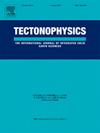2023年kahramanmaraki 7.8 Mw地震破裂增加了死海断层北部的潜在破坏
IF 2.7
3区 地球科学
Q2 GEOCHEMISTRY & GEOPHYSICS
引用次数: 0
摘要
2023年2月6日沿土耳其南部东安纳托利亚断层(EAF, Mw 7.8)和Çardak断层(CF, Mw 7.6)的地震序列揭示了地震间隙和断层段相互作用的重要性。两次大地震都表现出浅震源(<15 km),走滑机制,NE-SW走向的golba本文章由计算机程序翻译,如有差异,请以英文原文为准。
The 2023 Mw 7.8 Kahramanmaraş earthquake rupture increases potential failure along the northern Dead Sea Fault
The 6 February 2023 earthquake sequence along the East Anatolian Fault (EAF, Mw 7.8) and Çardak fault (CF, Mw 7.6) in southern Turkiye reveals the importance of seismic gaps and fault segments interaction. Both large earthquakes show shallow hypocentres (<15 km), strike-slip mechanisms, with the NE-SW trending Golbaşi-Kahramanmaraş-Karasu fault segments reaching ∼350 km and the E-W trending Çardak fault ∼150 km. Field investigations of surface ruptures, aided by Sentinel 2 image correlation, document the coseismic slip distribution, reaching 8 m on the Pazarcik segment and 4.1 m on the Kirikhan segment. Prior to the recent seismic sequence, our field investigations included the SW segments of the EAF and northern Dead Sea Fault (DSF). Detailed fault mapping was conducted from 2003 to 2007 along the EAF fault from Golbaşi to Antakia and along the DSF from the Ghab Basin to the Amik Basin and the intersection with the EAF. According to contemporaneous historical accounts, the 29 November 1114 earthquake that severely affected Antakia, Marash (Kahramanmaraş), Adiyaman and Urfa (Şanlurfa) causing 40,000 victims, may represent the predecessor to the 2023 Mw 7.8 earthquake. A possible evidence of fault interaction between the EAF and Dead Sea Fault (DSF) is shown by the southward migration of large historical earthquakes from the major 1114 CE seismic event on the SW EAF to the 1138 CE, 1156, 1170, and 1202 large earthquake sequences on the northern segments of DSF. The modelling of the seismic slip deficit and stress transfer illustrates the significant seismic hazard with the potential for a failure increase and a ∼ 21 year-time clustering of major events along the northern DSF segments.
求助全文
通过发布文献求助,成功后即可免费获取论文全文。
去求助
来源期刊

Tectonophysics
地学-地球化学与地球物理
CiteScore
4.90
自引率
6.90%
发文量
300
审稿时长
6 months
期刊介绍:
The prime focus of Tectonophysics will be high-impact original research and reviews in the fields of kinematics, structure, composition, and dynamics of the solid arth at all scales. Tectonophysics particularly encourages submission of papers based on the integration of a multitude of geophysical, geological, geochemical, geodynamic, and geotectonic methods
 求助内容:
求助内容: 应助结果提醒方式:
应助结果提醒方式:


